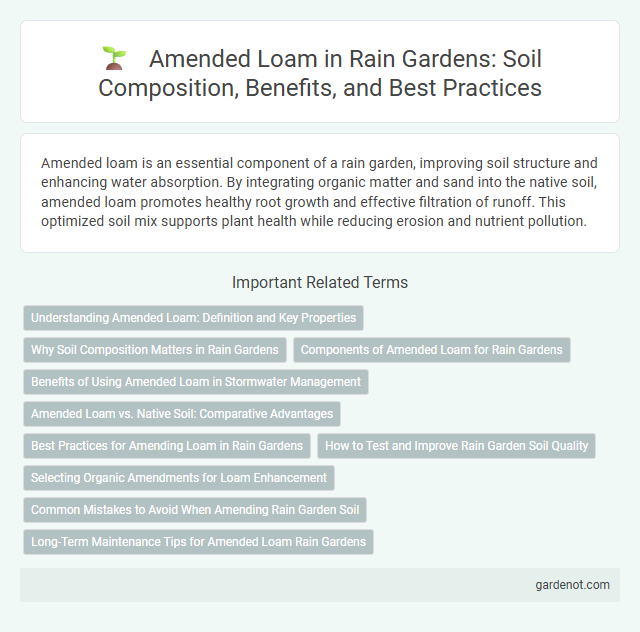Amended loam is an essential component of a rain garden, improving soil structure and enhancing water absorption. By integrating organic matter and sand into the native soil, amended loam promotes healthy root growth and effective filtration of runoff. This optimized soil mix supports plant health while reducing erosion and nutrient pollution.
Understanding Amended Loam: Definition and Key Properties
Amended loam is a soil mixture enhanced with organic matter such as compost, peat, or mulch to improve structure, aeration, and nutrient content. This modification increases water retention and drainage capacity, essential for the effective functioning of rain gardens by preventing runoff and promoting groundwater recharge. The key properties of amended loam include balanced texture, increased microbial activity, and improved soil fertility, supporting healthy plant growth and sustainable stormwater management.
Why Soil Composition Matters in Rain Gardens
Amended loam in rain gardens enhances soil permeability and nutrient retention, crucial for managing stormwater runoff efficiently. Proper soil composition supports deep root growth and microbial activity, improving water infiltration and pollutant filtration. Optimizing loam amendments ensures the rain garden sustains healthy plant life and reduces urban flooding risks.
Components of Amended Loam for Rain Gardens
Amended loam for rain gardens typically consists of a balanced mixture of native topsoil, organic compost, and sand or fine gravel to enhance drainage and nutrient retention. The organic compost improves soil structure and microbial activity, while sand increases permeability, preventing waterlogging and supporting healthy plant roots. This combination ensures optimal water infiltration and filtration, critical for effective stormwater management in rain garden ecosystems.
Benefits of Using Amended Loam in Stormwater Management
Amended loam enhances stormwater management by improving soil permeability and increasing water infiltration rates, reducing surface runoff and erosion. Its organic matter content supports microbial activity and root growth, promoting pollutant filtration and nutrient absorption. Using amended loam in rain gardens effectively mitigates flooding risks and improves groundwater recharge.
Amended Loam vs. Native Soil: Comparative Advantages
Amended loam in rain gardens offers enhanced nutrient retention and improved drainage compared to native soil, promoting healthier plant growth and efficient stormwater infiltration. Unlike native soil, which often contains compacted clay or poor organic content, amended loam is tailored with added compost and sand to optimize aeration and microbial activity. These modifications significantly reduce runoff and filter pollutants more effectively, making amended loam a superior medium for sustaining rain garden ecosystems.
Best Practices for Amending Loam in Rain Gardens
Amending loam for rain gardens involves integrating organic matter such as compost at a ratio of 20-30% to improve soil structure and enhance water infiltration. Testing soil pH and nutrient levels ensures balanced conditions for native rain garden plants, promoting optimal growth and pollutant filtration. Proper layering with amended loam and native soil supports strong root systems and maximizes the rain garden's effectiveness in stormwater management.
How to Test and Improve Rain Garden Soil Quality
Testing rain garden soil quality begins with collecting soil samples from various depths and locations, then analyzing texture, pH, nutrient levels, and organic matter content using a soil test kit or laboratory services. Improving soil quality involves amending native soil with loam enriched with compost or sand to enhance drainage, aeration, and nutrient retention, crucial for efficient rainwater infiltration. Regular monitoring and adjusting amendments based on test results ensures the soil maintains optimal properties for supporting diverse plant growth and effective stormwater management.
Selecting Organic Amendments for Loam Enhancement
Selecting organic amendments for loam enhancement in rain gardens improves soil structure, moisture retention, and nutrient availability. Compost, aged manure, and leaf mold are effective choices that increase organic matter and microbial activity in amended loam. These amendments support healthy root growth and promote efficient stormwater infiltration, essential for rain garden performance.
Common Mistakes to Avoid When Amending Rain Garden Soil
Using excessive organic matter in amended loam can lead to poor drainage and waterlogging in rain gardens, hindering plant growth. Avoid incorporating heavy clay without proper balancing as it may cause compaction, reducing soil aeration and root penetration. Ensure the loam mix maintains a balanced texture by blending sand, silt, and compost to promote optimal infiltration and nutrient retention.
Long-Term Maintenance Tips for Amended Loam Rain Gardens
Amended loam in rain gardens requires regular monitoring to maintain optimal soil structure and nutrient balance, ensuring efficient water infiltration and pollutant filtration. Periodic addition of organic matter and careful removal of sediment build-up prevent compaction and preserve soil porosity, enhancing the garden's long-term functionality. Implementing mulch layers and controlling invasive vegetation support soil health and promote sustained plant growth in amended loam rain gardens.
Amended loam Infographic

 gardenot.com
gardenot.com